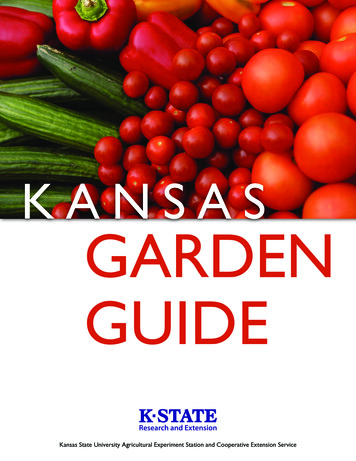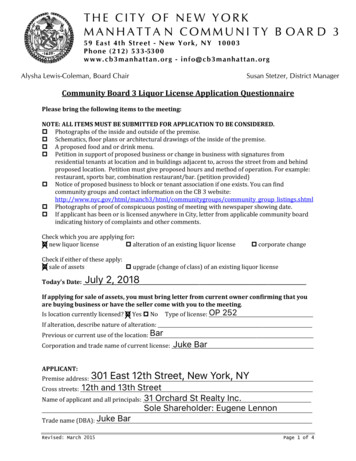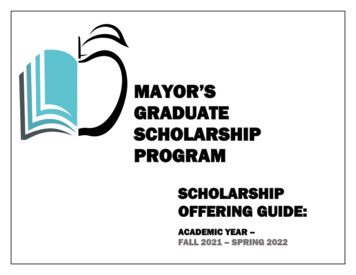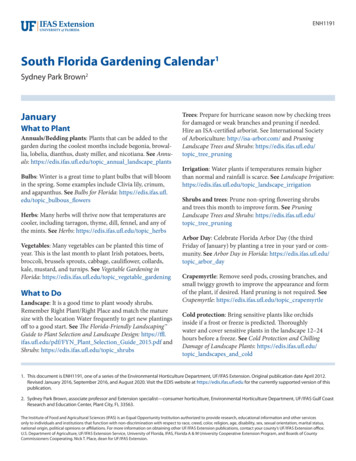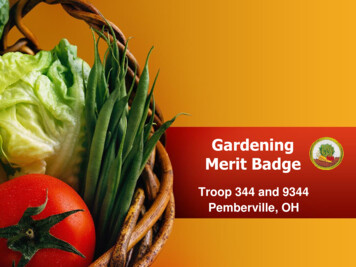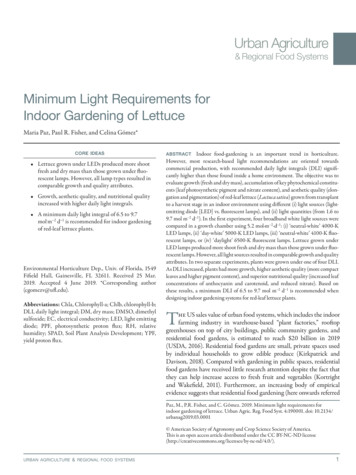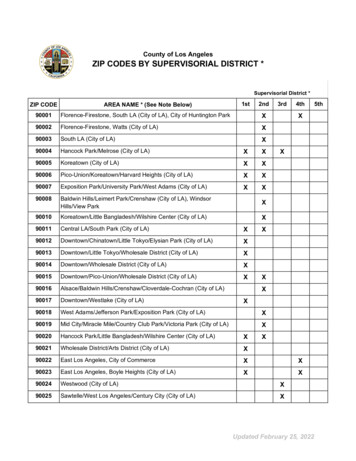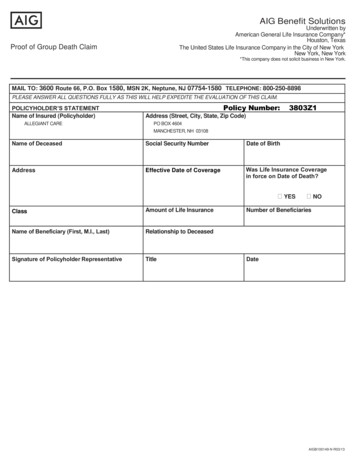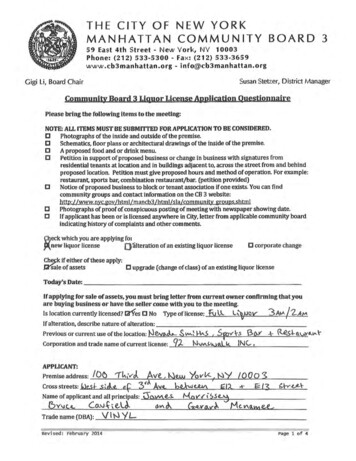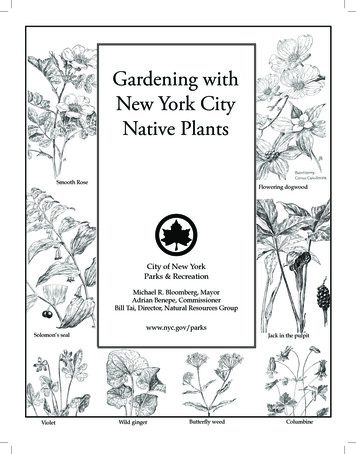
Transcription
Gardening withNew York CityNative PlantsSmooth RoseFlowering dogwoodCity of New YorkParks & RecreationMichael R. Bloomberg, MayorAdrian Benepe, CommissionerBill Tai, Director, Natural Resources Groupwww.nyc.gov/parksSolomon’s sealVioletJack in the pulpitWild gingerButterfly weedColumbine
What is a native plant?Why go native in the garden?A native plant is one that naturally occurs in a region without havingbeen introduced from elsewhere by people. New York City nativesinclude mosses, ferns, grasses, sedges and rushes, wildflowers, trees,shrubs, and vines.Sense of place: Why do yards and window boxes across thecountry hold the same impatiens, begonias and mums? Most ofAmerica’s favorite garden plants hail from places like Europe and Asia.The New York area has its own regional flavor and distinct assemblageof native plants. We should seek out alternatives to hardware stores,corner delis and other outlets that offer “one size fits all”. The NYCGreenmarkets, with their emphasis on locally grown greenery, canhelp you cultivate a sense of home by sowing local seeds.Over thousands of years, native plants have adapted to the climate,soils, and environmental conditions of our area. They have developedthe ability to thrive in our humid summers and freezing winters and toentice local insects, birds, and other animals to pollinate their flowersand disperse their fruits. Native plants are responsible for clean air,pure water, soil stability, flood abatement, and wild animal habitat.Humans depend on these ecological processes every day. Thus nativeplants are the building blocks of our biological diversity and essentialto healthy, functioning ecosystems.Unfortunately, many of these plants are in decline. Of 2,179 speciescurrently found in New York City, only 1,359 are native (62%).Additionally, many of our native species are now gone from the fiveboroughs. Such locally extinct plants include beautiful wildflowerslike white milkweed and pink ladyslipper orchid. Besides habitatprotection, one of the most important ways to give nature a hand isto use native plants in the garden and landscape.To determine whether a plant species naturally occurs in New YorkCity, you may use a number of sources. Consult a good field guidesuch as Peterson or Audubon series. Visit a nearby park nature center,arboretum, or botanical garden. Or join a local native plant club;attending frequent field trips will teach you about the local flora. Seethe Resources section for more information.What is an introduced plant?Every plant species is native to somewhere. Introduced (exotic, alien,non-native) plant species hail from other states, regions, or countries.This exotic flora was moved to new areas by people for food (apples, rice)or ornamentation (lilacs, peonies, Queen Anne’s lace) or by accident,as stowaways on commercials ships or packing materials. Over thepast 350 years, thousands of plant species have been introduced to theNew York area. Most live peacefully with the indigenous flora that wasalready here.What is an invasive plant?Unfortunately, a small but significant number of these introduced species areout of control. They travel from where they were planted (often through birddispersed seeds) and run rampant through our parks, damaging local forests,meadows and wetlands. These green bullies smother our native plants, shadingthem from the sun and effectively starving them to death. Some invasives are soclosely related to our indigenous flora that their pollens mix, producing hybridsthat overwhelm the local gene pool. This alters the plant’s biology, affectingfloral shape, color, or blooming time. Such dramatic change is potentiallydevastating for the wildlife that depends on native species. Thus invasive plantsdisrupt biological relationships and degrade natural areas.Ease of care: When installed in the appropriate habitat, nativeplants require less maintenance than the exotic alternatives. Onceestablished, they usually need less water. They require no fertilizer andlittle pest control, having evolved with the area’s insects and diseases.Native plants will save you money (on supplies) and time (on gardencare) and will also curtail the amount of toxins (pesticides, fertilizers)used to maintain artificial conditions.Wildlife bonanza:Create habitat havens for our native birds, bees, butterflies and othercritters. Native plants are critical sources of food and lodging forwildlife. For many locally rare animals, native plants are essential totheir survival. For example, the Federally-endangered Karner bluebutterfly feeds exclusively on wild blue lupine, both of which arenative to New York State. As forests, wet meadows and grasslandsare continually lost, gardeners can play an important role in creatinghabitat for our wild fauna and flora.Added beauty:New York City has hundreds of native species, most of which wouldbe a gorgeous addition to any garden. These attractive plants meetevery horticultural need from ground covers to lovely foliage andhardy bloomers, and all plant shapes: ferns, wildflowers, vines, shrubs,and trees. A native garden could bloom from March to November,providing year round beauty and interest.Preserve natural heritage:Our local biological diversity has suffered from an onslaught of exoticinvasive species. Some introduced garden plants, like dame’s rocket,Oriental bittersweet, privet and purple loosestrife have becomenoxious weeds. Adding homegrown greenery to your garden givesnatives a chance to reclaim the landscape.Cleaner waterways:Native grasses and wildflowers provide excellent erosion control.Increased biological diversity encourages rainwater to enter the soil.Monocultures of groundcover such as lawn, periwinkle, pachysandraand English ivy create high levels of water runoff, thus encouraginglocal drought conditions and polluting waterways during stormevents.
All plants listed are native to New York and hardy to zone 5.SUNNY WINDOW BOXES (and other dry sites)These plants naturally thrive in low nutrient soils (like sandy sites). The containershould comfortably hold at least 5” of soil, filled with a growing medium thatwill drain well, and placed in site with lots of sun.Wildflowers (forbs) Field pussytoes (Antennaria neglecta) Aster family. Grows to16 in. Flowers small, white, May-July. Wild columbine (Aquilegia canadensis) Buttercup family. Growsto 18 in. Unique red and yellow flowers attract hummingbirdsin spring. Butterfly weed (Asclepias tuberosa) Milkweed family. Grows to 2 ft.Flowers bright orange, showy, July-August. Attracts butterflies.Foliage is a favorite food of Monarch caterpillars. Smooth blue aster (Aster laevis, syn. Symphyotrichum laeve) Asterfamily. Grows to 3 ft. Flowers blue, showy, Aug.-Oct. Attractsbutterflies. Smooth blue-green foliage and stems. Wild blue lupine (Lupinus perennis) Pea family. Grows to 2 ft.A spire of showy blue flowers in May above dissected foliage.Attracts butterflies. Sole food source for Karner blue butterfly. Spotted bee-balm (Monarda punctata) Mint family. Grows to3 ft. Flowers yellowish with purple spots, July-Oct. Attractsbutterflies & hummingbirds. Prickly pear cactus (Opuntia humifusa) Cactus family. Grows to1ft., evergreen stems “paddles”, colonial, prickly. Yellow, showyflowers in June-July, red fleshy fruit, edible, Oct-Nov. Seaside goldenrod (Solidago sempervirens) Aster family. Growsto 5 ft. Large, showy yellow flowers in Aug-Oct. Attractsbutterflies. Also try rough goldenrod (S. rugosa). Birdfoot violet (Viola pedata) Violet family. Grows to 6 in.Flowers lilac-violet with conspicuous orange centers in springabove dissected foliage. Attracts butterflies.Virgin’s bowerNative PlantSuggestionsShrub Bearberry (Arctostaphylos uva-ursi) Heath family. Grows to 6 in.,evergreen leaves on a trailing woody stem. White flowers inlate spring; red fleshy fruits in late summer persist into winter.Grasses Purple lovegrass (Eragrostis spectabilis) Grass family. Grows to2 ft. Flowers purple, showy, late summer. Puffsheath dropseed (Sporobolus neglectus) Grass family. Annualgrowing to 20 in. Blooms Aug.-Oct. Also see poverty-grass(Sporobolus vaginiflorus).
POTTED SHADE GARDENSGROUNDCOVERS TO BLANKET BARE SPOT“Shade” does not mean “utter darkness.” Dappled sunlight throughoutthe day or attenuated light for at least 4 hours is the minimumrequired. Soils should have a healthy dose of organic material and bekept consistently moist. Note the many members of the Lily family,a group well-represented on our forest floors. Consider a collectionof lilies. Another lovely combination is ferns mixed with springephemerals. The fronds begin to expand as the flowers die out.Wildflowers (forbs) Wild ginger (Asarum canadense) Birthwort family. To about 8 in.tall. Leaves lustrous green. Flowers hidden below leaves, deeppurple-brown, April-May. Very shade tolerant. Wild geranium (Geranium maculatum) Geranium family. Growsto 22 in. Showy pink-purple flowers are held aloft cut foliage inApril-June. Attracts butterflies. Shade tolerant. Spreads slowly. Twoleaf mitrewort (Mitella diphylla) Saxifrage family. Grows to16 in. Flowers white, scattered along inflorescence, April-May.Also try foam flower (Tiarella cordifolia). Mountain phlox (Phlox subulata) Pink family. To about 8 in.tall. Showy purplish pink flowers attract butterflies in May-July.Prefers dry, non-fertilized soils. Great for rock gardens. Old field cinquefoil (Potentilla simplex) Rose family. Grows to 1 ft.Leaves are semi-evergreen. Flowers yellow, April-June. Try alsoSilverweed (P. anserina). Common blue violet (Viola sororia) Violet family. To about 6 in.tall. Flowers violet April-May. Attracts butterflies. Tolerant ofpartial shade. Freely self-sows, naturalizing in most areas. Barren strawberry (Waldsteinia fragarioides) Rose family. Growsto 6 in. Small clusters of yellow flowers in spring. Evergreenfoliage turns bronze in winter.Wildflowers (forbs) Wild leek (Allium tricoccum) Lily family. Grows to 1ft. Broadleaves die back before flowers (white) bloom in April-May.Spring ephemeral. Jack-in-the-pulpit (Arisaema triphyllum) Arum family. One ofthe few native species of this tropical family. Grows to 2 ft.Unique flowers in May. Heart-leaved aster (Aster cordifolius, syn. Symphyotrichumcordifolium) Aster family. Grows to 4 ft. Flowers powder blue,showy, Aug.-Oct. Attracts butterflies. Also try white wood aster(Aster divaricatus syn. Eurybia divaricata). These two asters arevery common in the city’s woodland understory. Round-lobed hepatica (Hepatica americana) Buttercup family.Grows to 6 in., semi-evergreen. Delicate blue-lavender flowersin March-April. One of our first wildflowers to bloom. Mottledleaves unfurl after petals have dropped. Spring ephemeral. Smooth Solomon's seal (Polygonatum biflorum) Lily family.Grows to 3 ft. Gracefully arching stems punctuated by bellshaped greenish-white flowers in May-June. Red berries followin late summer. Try also hairy Solomon’s seal (P. pubescens) andfalse Solomon’s seal (Smilacina racemosa). Blue-stemmed goldenrod (Solidago caesia) Aster family. Grows to3 ft. Flowers yellow, showy, Aug.-Oct. Attracts butterflies. Tryalso Zig zag goldenrod (S. flexicaulis). Wake robin (Trillium erectum) Lily family. Grows to 16 in.Flowers dark red, large and showy, April-June. Spreads slowly.Our hardiest trillium. NYC once had many species of thisquintessential wildflower growing in our forests. Today they areall extinct in the five boroughs. Perfoliate bellwort (Uvularia perfoliata) Lily family. Grows to1 ft. Bell-shaped yellow flowers, May-June. Yellow forest violet (Viola pubescens) Violet family. Grows to 18 in.Flowers yellow, showy, April-May. Attracts butterflies. There aremany species of shade tolerant violets that are native to our area.Try also V. blanda (white flowers) and V. palmata (purple flowers).Ferns Cinnamon fern (Osmunda cinnamomea) Fronds to 3 ft.Cinnamon-colored chaff mid-frond. Tolerates wet soils. Leavedead fronds over winter to protect plant. Try also O. claytonia. Royal fern (Osmunda regalis) Fronds to 4 ft. Tolerates wet soils.Very attractive and distinctive sterile fronds. Maidenhair fern (Adiantum pedatum) Fronds to 3 ft. A delicatespiral of airy leaflets on black, wiry stems. Spreads slowly, droughttolerant once established. One of our most beautiful native ferns.Ferns Hay-scented fern (Dennstaedtia punctilobula) Fronds to 32 in.Colonial, forming a carpet over time. Light green, lacy frondssmell sweet early in the season. Extremely drought tolerantonce established. Sensitive fern (Onoclea sensibilis) Fronds to 1 ft. Very attractivereproductive fronds, like a cluster of small black beads and doeswell in full sun, but keep moist, it’s sensitive to drought. New York fern (Thelypteris noveboracensis) Fronds to 18 in.Colonial, forming a carpet over time. Frond tapers to base.Graminoids (grasses & sedges) Pennsylvania sedge (Carex pensylvanica) Sedge family. Growsto 12 in., leaves semi-evergreen, forming patchy ground cover(grows in clumps). Blooms April-July. Seeds eaten by songbirds. Sideoats grama (Bouteloua curtipendula) Grass family. Grows 2.5 ft.,showy seedheads attract birds. Turns a burnished orange in fall.Vines Partrideberry (Mitchella repens) Madder family. Grows to 8 in.Small, oval evergreen leaves with pairs of white flowers insummer; scarlet berries all winter. Tolerates shade and dry soils. Virginia creeper (Parthenocissus quinquefolia) Grape family.Climbing woody vine or ground cover, quick growing. Foliageturns beautiful reds in autumn. Deep blue fruits in fall eaten bymigratory birds. Allegheny pachysandra (Pachysandra procumbens) Boxwoodfamily. This pachysandra is native to PA and south, whereas theone sold at most nurseries is from Japan and can be invasive.The native vine has attractive foliage, two-toned leaves.
BUTTERFLY GARDENThe Composite family (Asteraceae) is arguable the best family for nectarplants. Examples of genera from this family include Aster, Eupatorium,Coreposis, Helianthus, Liatris, Solidago and Vernonia. Other familieswith attractive blooms for butterflies are Parsley family-Apiaceae(Heracleum, Osmorhiza, Zizia), Milkweed family-Asclepidaceae (Asclepias),Pea family-Fabaceae (Baptisia, Desmodium, Lespedeza, Lupinus), Mintfamily-Lamiaceae (Agastache, Monarda), and Violet family-Violaceae(Viola). Both the plants and butterflies prefer sunny locations. N.B.Butterfly bush (Buddleja species) can be invasive. Consider instead thenatives below.Don’t forget food for caterpillars. Such host plants include sedges(Carex spp.), bulrushes (Scirpus spp.), grasses (Panicum spp.), trees(e.g., poplars, birches, oaks, hickories); shrubs (e.g., dogwoods,willows, spicebush, viburnums), etc.Wildflowers (forbs)Clasping milkweed (Asclepias amplexicaulis) Grows to 32 in.Flowers pink-purple, June-July. Other native milkweed species:common milkweed (A. syriaca) to 6 ft., flowers lavender, fragrant,swamp milkweed (A. incarnata) to 4 ft., magenta flowers, tolerantof wet soils.Cow parsnip (Heracleum lanatum) Grows to 10 ft., flowers white,June-July. Also in the Parsley Family (with that Queen Anne’s lacelooking floral cluster): hairy sweet cicely (Osmorhiza claytonii) Growsto 2 ft., flowers white, May-June. Try also O.longistyli; goldenalexanders (Zizia aurea) to 32 in., flowers yellow, showy, April-June.Wild bergamot (Monarda fistulosa) Grows to 4 ft. Flowers lilac orpink, July-Sept. Other native Monarda species, (all 3 species also attracthummingbirds): horse mint (M. punctata) to 3 ft, yellow flowers withpurple spots and bee balm (M. didyma) to 4 ft., red flowers.Seaside goldenrod (Solidago sempervirens) Grows to 6 ft, flowersyellow, showy, Aug-Oct. Large, fleshy green leaves and beautiful redstems in fall. Other native goldenrod species: S. juncea, S. nemoralis,S. odora, S. rugosa.Also consider Dutchman's pipe (Aristolochia macrophylla) Birthwort family.Grows to 30 ft. Well-behaved twining woody vine grown forlarge, shady foliage. Critical food source for larvae of thepipevine swallowtail butterfly. Rose mallow (Hibiscus moscheutos) Mallow family. Tropicallooking, showy white or pink flowers in summer. Intolerant ofdrought. Blue flag iris (Iris versicolor) Iris family. Grows to 3 ft. Swordshaped, blue-green leaves with showy violet-blue flowers inearly summer. Also try I. prismatica. Cardinal flower (Lobelia cardinalis) Bellflower family. Grows to 4ft. Striking scarlet flowers in late summer. Also try L. siphilitica. Blue vervain (Verbena hastata) Vervain family. Elongatedleaves; small blue flowers in terminal spikes in summer. Alsotry V. stricta.SHOWY TREES & SHRUBSNative Small Trees, Tall Shrubs Shadbush (Amelanchier canadensis) Rose family. Grows to 25 ft.Multi-stemmed shrub with showy white flowers in April-May;edible purple fruits June-July. Fall foliage. Attractive bark. Gray birch (Betula populifolia) Birch family. Grows to 30 ft., oftenmulti-stemmed. Striking bark - white with black markings. Nice fallcolor. Adds winter interest to the garden or yard. Common hackberry (Celtis occidentalis) Elm family. Grows to 70 ft.(usually much smaller), flowers April-May; black fruits Sept.Oct. Beautiful silvery bark, corky and textured with age. Hostto larvae of some butterflies. Flowering dogwood (Cornus florida) Dogwood family. Growsto 40 ft., fall color, showy white (sometimes pink) flowersin April-June; red fleshy fruit in Oct.-Nov. Valuable to fallmigrating birds. Bark ages to an attractive patchwork ofsquares. Witch hazel (Hamamelis virginiana) Witch hazel family. Growsto 25 ft. Multi-stemmed shrub with unusual yellow flowers thatbloom late, Oct.-Nov. Smooth gray bark. Small brown nuts inlate fall provide food for wildlife. Shade tolerant.Native Smaller Stature Shrubs New Jersey tea (Ceanothus americanus) Buckthorn family. Growsto 4 ft.; creamy white flowers June-July, when flowers are few.Attracts butterflies. Inkberry (Ilex glabra) Holly family. Grows to 6 ft., evergreen;small white flowers June-July; black fleshy fruits in Sept.-Nov.,eaten by birds. (N.B. male and female flowers are on separateplants, both sexes must be present for fruit production). Winterberry (Ilex verticillata) Holly family. Grows to 15 ft., smallwhite flowers June-July, red fleshy fruits in Sept.-Oct, eaten bybirds. (N.B. male and female flowers are on separate plants,both sexes must be present for fruit production). Northern bayberry (Myrica pensylvanica) Bayberry family. To10ft., tends to sucker into large colonies. Silvery bark. Holdsleaves all winter. Both male and female plants are necessary toinsure fruit production. Waxy berries provide food for winterresident and spring migratory birds. Beach Plum (Prunus maritima) Rose family. To 6 ft., attractivebark. Beautiful sculpted branching patterns. Showy whiteflowers early summer before leaves, edible fruits mid-summer. Pinkster azalea (Rhododendron periclymenoides) Heath family.Grows to 6 ft.; gorgeous tubular pink flowers, lightly fragrant,attracts humming birds in April-May. Will spread throughstolons if conditions are right. Highbush blueberry (Vaccinium corymbosum) Heath family.Grows to 9 ft., fall foliage; small, bell-shaped white flowersMay-June, blue edible fruits July-Aug., eaten by wildlife. Hostto larvae of some butterflies.
ResourcesBooks Cullina, William. 2000. The New England Wild Flower Society Guideto Growing and Propagating Wildflowers of the United States andCanada. Boston, MA: Houghton Mifflin Company. 384 pp. Cullina, William. 2002. Native Trees, Shrubs & Vines: A Guide toUsing, Growing, and Propagating North American Woody Plants.Boston, MA: Houghton Mifflin Company. 376 pp. Darke, Rick. 2002. The American Woodland Garden: Capturing theSpirit of the Deciduous Forest. OR: Timber Press. 376 pp. Stein, Sara. 1993. Noah’s Garden: Restoring the Ecology of Our OwnBack Yards. Boston: Houghton Mifflin. 304 pp. Stein, Sara. 1997. Planting Noah’s Garden. Boston: HoughtonMifflin. 464 pp.Inspiration for the Garden - Nature in New York City New York City Department of Parks & Recreation, NaturalResources Group – “Forever Wild” programwww.nyc.gov/foreverwild BBG Native Plant Gardenwww.bbg.org/exp/stroll/nativeflora.htmlWood lilyGardening with Native Plants Bowman’s Hill Wildflower Preserve www.bhwp.org Green Landscaping with Native Plantswww.epa.gov/reg3esd1/garden/index.htm Landscaping for a Healthy Planetwww.envirolandscaping.org/ Local Ecotype Guidelineswww.for-wild.org/land/ecotype.html Native Gardening and Invasive Plants Guideenature.com/native invasive/natives.asp Smaller American Lawns Todayarboretum.conncoll.edu/salt/salt.htmlCreating Habitat for Native Wild Animals Backyard Wildlife Habitatwww.nwf.org/backyardwildlifehabitat/ MonarchWatch Butterfly Gardeningwww.monarchwatch.org/garden/creating.htm Wild Acres of Maryland www.dnr.state.md.us/wildlife/wildacres.aspNative Plant Organizations Lady Bird Johnson Wildflower Center www.wildflower.orgAlso has a satellite office in Westchester County Connecticut Botanical Society www.ct-botanical-society.org Long Island Botanical Society libotanical.org (no www) The New England Wild Flower Society www.newfs.org The Native Plant Society of New Jersey www.npsnj.org New York Flora Association www.nyflora.org Torrey Botanical Society www.torreybotanical.orgA publication of the New York City Department of Parks & Recreation, Natural Resources GroupText: Mariellé Anzelone, Design: Toby Allan Schust
to use native plants in the garden and landscape. To determine whether a plant species naturally occurs in New York City, you may use a number of sources. Consult a good field guide such as Peterson or Audubon series. Visit a nearby park nature center, arboretum, or botanical
